ChemComm: onwards and upwards
Abstract
Welcome to the first issue of ChemComm in 2013. We would like to share with you some of our highlights from what has been a very busy year, as well as inform you of some new developments for the journal. We want to wish all our authors, readers and reviewers a Happy New Year as we look forward to another exciting year for ChemComm.
100 and counting
2012 saw ChemComm move to 100 issues a year—this bold move was in response to the increasing number of submissions received to the journal, which now sees ChemComm publishing over 3000 communications a year, that’s over twice as many articles as five years ago. We are pleased to say that the growth of the journal has not come at the expense of quality—with nearly 10![[thin space (1/6-em)]](https://www.rsc.org/images/entities/char_2009.gif) 000 submissions this year, the rejection rate has now risen to over 65%, meaning only highly topical and cutting edge communications are selected for publication in ChemComm. We also saw yet another rise in impact factor to 6.17 (2011 Journal Citation Reports®). The quality of work published in ChemComm is showcased by the most-read Feature articles (Table 1) and communications (Table 2) from the last 12 months.
000 submissions this year, the rejection rate has now risen to over 65%, meaning only highly topical and cutting edge communications are selected for publication in ChemComm. We also saw yet another rise in impact factor to 6.17 (2011 Journal Citation Reports®). The quality of work published in ChemComm is showcased by the most-read Feature articles (Table 1) and communications (Table 2) from the last 12 months.
| Title | Authors | DOI |
|---|---|---|
| Graphene quantum dots: emergent nanolights for bioimaging, sensors, catalysis and photovoltaic devices | Jianhua Shen, Yihua Zhu, Xiaoling Yang and Chunzhong Li | 10.1039/c2cc00110a |
| N-Heterocyclic carbene chemistry of iron: fundamentals and applications | Michael J. Ingleson and Richard A. Layfield | 10.1039/c2cc18021a |
| Routes to copper zinc tin sulfide Cu2ZnSnS4 a potential material for solar cells | Karthik Ramasamy, Mohammad A. Malik and Paul O'Brien | 10.1039/c2cc30792h |
| Control the size and surface chemistry of graphene for the rising fluorescent materials | Shoujun Zhu, Shijia Tang, Junhu Zhang and Bai Yang | 10.1039/c2cc31201h |
| Diketopyrrolopyrrole (DPP)-based materials for organic photovoltaics | Sanyin Qu and He Tian | 10.1039/c2cc17886a |
| Title | Authors | DOI |
|---|---|---|
| Enhancing the Stokes' shift of BODIPY dyes via through-bond energy transfer and its application for Fe3+-detection in live cell imaging | Xingyu Qu, Quan Liu, Xiaoning Ji, Huachao Chen, Zhikuan Zhou and Zhen Shen | 10.1039/c2cc31011b |
| Facile synthesis of silicon nanoparticles inserted into graphene sheets as improved anode materials for lithium-ion batteries | Xiaosi Zhou, Ya-Xia Yin, Li-Jun Wan and Yu-Guo Guo | 10.1039/c2cc17061b |
| Silver(i)-catalyzed carboxylation of arylboronic esters with CO2 | Xiao Zhang, Wen-Zhen Zhang, Ling-Long Shi, Chun-Xiao Guo, Ling-Ling Zhang and Xiao-Bing Lu | 10.1039/c2cc32045b |
| Porous salts based on the pamoate ion | Helene Wahl, Delia A. Haynes and Tanya le Roex | 10.1039/c2cc14753j |
| A selective reaction-based fluorescent probe for detecting cobalt in living cells | Ho Yu Au-Yeung, Elizabeth J. New and Christopher J. Chang | 10.1039/c2cc31681a |
These positive developments for the journal mean that ChemComm leads the way as the largest international publisher of high-quality communications within general chemistry.
To celebrate this exciting new era, ChemComm will be publishing a new type of article from 2013; Viewpoints will highlight some of the seminal research published in ChemComm and its predecessors over the last 100 years. We aim to publish 100 Viewpoints—so start counting and make sure you (or we) don’t miss one! We will also continue to publish interviews with some of our most loyal authors; you can view all of the ChemComm Author Interviews on our website as they are published.
Editorial Board changes
In addition to welcoming Richard Schrock (MIT, USA) into his new role as Chair of the ChemComm Editorial Board, this year we were also pleased to announce the appointment of several new Associate Editors. Yong-Qiang Tu (Lanzhou University, China) and S. Ramakrishnan (Indian Institute of Science, Bangalore, India) are now handling submissions in the areas of organic chemistry and organic materials/polymers, respectively. Penny Brothers (University of Auckland) will also continue on the Editorial Board as an Associate Editor with expertise in supramolecular and inorganic chemistry. These appointments add to the expertise of our existing Associate Editors—we encourage you to submit your next Communication to their Editorial Offices—their details can be found on the ChemComm website.We would like to sincerely thank our retiring board members, Heather Maynard, Keiji Maruoka and Nick Turner, for their dedication and support of the journal. The Advisory Board has also seen a significant change this year, with many new enthusiastic members joining the ChemComm team. We look forward to working with them all. You can find information about all the ChemComm Editorial and Advisory Board members on our website www.rsc.org/chemcomm.
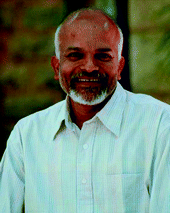 S. Ramakrishnan
S. Ramakrishnan
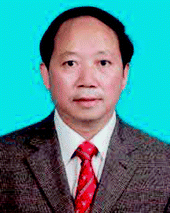 Yong-Qiang Tu
Yong-Qiang Tu
Supporting up-and-coming researchers
ChemComm is dedicated to supporting up-and-coming researchers and we have been delighted with the success of our Emerging Investigators issues. Both the collections in 2011 and 2012 were bumper issues, highlighting their popularity and the high volume of great new research being published by the next generation of world-leading scientists. We have already received a large number of submissions for our 2013 Emerging Investigators issue, many of which are already published online, and we look forward to seeing this popular issue in print soon.This year we will also award the 3rd ChemComm Emerging Investigator Lectureship. The lectureship, which is awarded annually, recognises an emerging scientist in the early stages of their independent academic career. The 2012 winner was Professor Hiromitsu Maeda for his contributions to the field of organic chemistry, supramolecular chemistry and materials science. Professor Maeda has just completed his lecture tour around the UK, where he gave talks in Southampton, Bath and Glasgow, as well as an invited talk at the International Conference on Physical Organic Chemistry (ICPOC) in Durham.
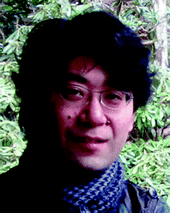 2012 winner: Hiromitsu Maeda
2012 winner: Hiromitsu Maeda
Nominations for the 2013 ChemComm Emerging Investigator Lectureship closed in December and the winner will be announced very soon.
Web themes
Web themed issues are an important part of ChemComm, allowing us to highlight current topical subjects and to attract research from exciting new areas of the chemical sciences. This year ChemComm has showcased a lively mix of web themes which can be seen in Table 3. You can view all our themed collections on the ChemComm website. Next year we have more exciting web themes planned, including Mechanochemistry, Microfluidics and Medicinal Inorganic Chemistry. We welcome suggestions for new web themed issues, so please get in touch with your ideas.| 2012 Web themed issues | Guest Editors |
|---|---|
| Organocatalysis | Keiji Maruoka, Hisashi Yamamoto, Liu-Zhu Gong and Benjamin List |
| Chirality | David Amabilino and Eiji Yashima |
| Metal–organic frameworks | Neil Champness, Christian Serre and Seth Cohen |
| Ionic liquids | Robin D. Rogers, Douglas MacFarlane and Suojiang Zhang |
| Porphyrins and phthalocyanines | Jonathan Sessler, Penny Brothers and Chang-Hee Lee |
| Aromaticity | Nazario Martín, Michael Haley and Rik Tykwinski |
| Frontiers in molecular main group chemistry | Manfred Scheer and Richard Layfield |
| Nucleic acids | Mike Gait, Makoto Komiyama, David Liu, Jason Micklefield, Ned Seeman and Oliver Seitz |
International profile
ChemComm has a long history as a society journal and is proud to support the scientific community. The journal continues to sponsor a variety of international meetings, as well as awarding prizes to some of the best up-and-coming new scientists across the world.In 2013, we will continue to attend international conferences, to ensure we are aware of the latest ‘hot’ topics and cutting-edge research. This is also a great opportunity to meet our authors, readers and referees, so if we are at a conference you’re attending, please do come and say hello—we’d love to get your feedback on ChemComm.
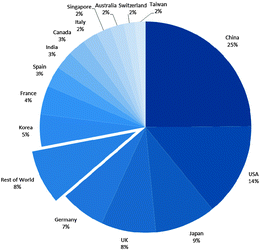 | ||
| Fig. 1 An international journal: articles published in ChemComm by country in 2011. | ||
ChemComm is keen to support and promote research and collaborations internationally. For example, to support the UK research community in 2012 we hosted two ChemComm—RSC Prizes & Awards Symposia in association with RSC member divisions. A symposium with the Analytical Division on (bio)analytical science was held at Imperial College London in February, and another in Oxford on inorganic and supramolecular chemistry in collaboration with the Dalton Division in May. Our thanks go to Tony Cass and Simon Aldridge for their help in organising these great events, which helped to further engage ChemComm with the UK chemical science community.
Following on from the highly successful symposium held in Asia in 2011, in November this year the 6th ChemComm International Symposium took place in Brazil. The theme was chemistry and sustainable energy, and brought together world-leading scientists for stimulating discussion and collaborations. It was also the first RSC Journal Roadshow to take place in South America—showcasing the truly international nature of ChemComm and RSC Publishing. ChemComm plans to continue these successful symposia both within the UK and overseas—so watch out for details on forthcoming events in the New Year. The 6th ChemComm International Symposium in Rio de Janeiro, Brazil
The 6th ChemComm International Symposium in Rio de Janeiro, Brazil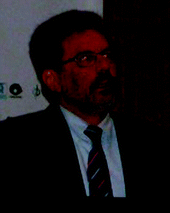 Plenary Speaker: Carlos H. de Brito Cruz, Scientific Director FAPESP
Plenary Speaker: Carlos H. de Brito Cruz, Scientific Director FAPESP
The Editorial Office continues to work hard to make sure the work published in ChemComm has the highest visibility possible. We promote the latest high-quality research and news from the ChemComm blog and Twitter feed @ChemCommun—we encourage you to sign-up and follow our tweets today at http://twitter.com/ChemCommun.
Our dedicated Press Office also promotes ChemComm articles to the wider scientific press, with articles being featured in leading international scientific magazines, such as Nature, Chemistry World and C&EN. Examples include Julius Rebek’s communication on deep cavitand vesicles (10.1039/c2cc34065h) and an article on the detection of nerve gas agents by José-L. Vivancos and colleagues (10.1039/c2cc34662a).
Looking forward
We want to thank everyone in the scientific community who has contributed to ChemComm. It is the support of our authors, Board members, readers and referees who have made ChemComm the journal it is today. We take this opportunity to especially thank our referees as their dedication and support is invaluable to the success of the journal.As you have seen, ChemComm has had a very busy year with lots of exciting changes and developments. We look forward to welcoming our new Associate Editors and Advisory Board members into their new roles, and with their support, ChemComm plans to have another eventful year in 2013!
We always welcome your feedback, comments and suggestions; please do contact us at ChemComm-RSC@rsc.org.
With our best wishes for the New Year, Richard R. Schrock, Editorial Board Chair, Robert Eagling, Managing Editor, Philippa Ross, Senior Publishing Editor and Jane Hordern, Deputy Editor
| This journal is © The Royal Society of Chemistry 2013 |
